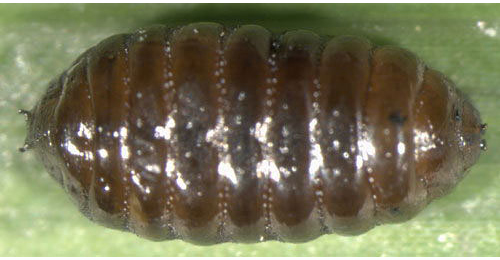|
||||||
| Agromyza
phragmitidis Hendel, 1922 [Diptera: Agromyzidae] |
||||||||||||||||||||||||||||||||||||||||||||||||||||||||||||||||
|
Agromyza
phragmitidis Hendel, 1922. Wien. ent. Ztg. 39:
65 |
||||||||||||||||||||||||||||||||||||||||||||||||||||||||||||||||
|
Leaf-miner: Several eggs are normally laid together side by side at the tip of the leaf, the young larvae feeding first towards the apex of the leaf and then forming a large communal blotch running down the leaf. Pupation normally external, frequently adhering to the leaf (Spencer, 1976: 132). A number of eggs are deposited in a transverse row, not far from the leaf margin. The larvae that emerge start to make an individual corridor in the direction of the leaf tip. The corridors quickly widen and merge into one communal, upper-surface, mine. Frass powdery. Pupation as a rule outside the mine (Bladmineerders van Europa). Larva: The larvae of flies are leg-less maggots without a head capsule (see examples). They never have thoracic or abdominal legs. They do not have chewing mouthparts, although they do have a characteristic cephalo-pharyngeal skeleton (see examples), usually visible internally through the body wall. The somewhat greenish larva is described by Griffiths (1963), de Meijere (1925) and illustrated in Bladmineerders van Europa. Puparium: The puparia of flies are formed within the hardened last larval skin or puparium and as a result sheaths enclosing head appendages, wings and legs are not visible externally (see examples). The puparium is illustrated in Bladmineerders van Europa. It varies in colour from black to almost yellow; posterior spiracular processes separated by their own diameter, each with 3 bulbs (Spencer, 1976: 132).
Hosts in Great Britain and Ireland:
Hosts elsewhere:
Time of year - mines: August-September. Time of year - adults: April-August the following year. Distribution in Great Britain and Ireland: Widespread in Britain (Spencer, 1972b: 38) including Huntingdonshire and Oxford (Robbins, 1991: 141), East Perth (Ardblair Moss), Haddington (Luffness) (Bland, 1994c: 81) and Cambridgeshire, East Cornwall, East Suffolk (NBN Atlas). Also recorded in the Republic of Ireland (Fauna Europaea). Distribution elsewhere: Widespread in continental Europe including Denmark, Finland, Germany, Hungary, Poland (Spencer, 1976: 132), The Netherlands (Bladmineerders van Europa), Belgium (Scheirs and de Bruyn, 1992), Czech Republic, Estonia, Hungary, Lithuania, Poland and Slovakia (Fauna Europaea). Also recorded in Japan (Spencer, 1990). NBN Atlas links to known host species:
British and Irish Parasitoids in Britain and elsewhere:
|
|
|
|
| External links: | Search the internet: |
|
Biodiversity Heritage Library Bladmineerders van Europa British leafminers Encyclopedia of Life Fauna Europaea NBN Atlas NHM UK Checklist |
Find
using Google Find using Google Scholar Find images using Google |
| Last updated 08-Oct-2019 Brian Pitkin | ||

